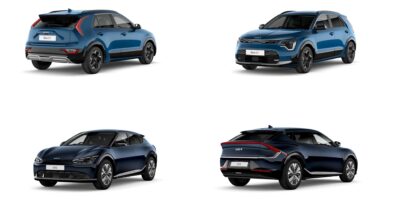Twelve per cent more powerful. Twelve per cent faster. Ford today revealed that the all-new Ford Focus ST five-door sprints from 0‑62mph in 5.7 seconds – 0.8 seconds quicker than the previous generation model.
Powered by a 280PS 2.3-litre EcoBoost petrol engine – 30PS more than the preceding Focus ST – the all-new model also achieves even faster in-gear acceleration than the acclaimed previous generation Focus RS.
Twin-scroll turbocharging technology contributes to segment-leading peak torque of 420Nm for immediate response to throttle inputs, and an innovative anti-lag system enables rapid delivery of boost on demand. Flat-shift capability for the six-speed manual gearbox and Launch Control* also help optimise standing start performance.
“The all-new Focus ST is about more than just straight-line speed, but the ability to go toe-to-toe with the now legendary Focus RS over a quarter-mile sprint shows just how much the Ford Performance team has moved the game on in the last four years,†said Leo Roeks, Ford Performance director, Europe. “We’ve drawn inspiration from the Ford GT supercar, F‑150 Raptor pick-up, Ford Mustang and Fiesta ST to develop a Focus ST capable of punching you in the back the moment you hit the throttle.â€
The Focus ST 2.3-litre EcoBoost’s low-inertia twin-scroll turbocharger scavenges exhaust gasses more effectively to optimise the energy transferred into the turbine wheel – producing more power and delivering boost pressure faster. Separated exhaust channels transfer the gas pulses from cylinders one and four, and two and three – minimising pulse interference for a consistent flow of energy.
Anti-lag technology can electronically hold the throttle open for up to three seconds after the driver backs off the accelerator, alleviating the reversal of airflow from the turbocharger to maintain compressor wheel speed.
By keeping the turbocharger primed for immediate response and maintaining positive pressure in the intake manifold when off throttle, the innovative technology allows faster resumption of both boost pressure and optimised combustion when the driver returns to the accelerator. In addition, an electronically actuated turbocharger waste-gate allows closer control of boost pressures for enhanced engine performance.
Flat-shift capability can also help deliver ultimate standing start acceleration by automatically emulating anti-lag and holding the throttle open as the driver disengages the clutch to shift up through the short-throw, six-speed manual gearbox – maximising turbocharger response. A gear-shift indicator light, available with the optional Performance Pack, lets drivers know the optimal point to change gears, and Launch Control can be engaged to maximise grip off the line for consistently fast standing starts.
The all-new Focus ST’s straight-line speed is matched by its cornering ability, optimised using Ford’s first electronic limited-slip differential for a front-wheel drive model. Incorporated into the six-speed manual and seven-speed automatic transmissions for 2.3-litre EcoBoost models, the system uses hydraulically activated clutches to redistribute up to 100 per cent of available engine torque to the wheel with more traction to counteract wheelspin. The result is increased agility and a significant reduction in understeer during acceleration through, and out of, corners.
Faster to deploy and offering greater precision than a traditional mechanical limited-slip differential the system can pre-emptively adjust torque distribution using inputs from powertrain and vehicle dynamics sensors, and can apply differential locking gradually for fine-tuning performance.
In addition, Focus ST five-door models feature Continuously Controlled Damping technology that monitors suspension, body, steering and braking inputs every two milliseconds to adjust damping responses for optimised ride quality and driving dynamics. The system features three pre-set levels of damping to support the Focus ST’s Selectable Drive Modes; one for Slippery/Wet and Normal modes; one for Sport mode; and another – delivering up to twice the vertical load resistance of Sport mode – for Track mode.*
The Focus ST also delivers greater stopping power than even the previous generation Focus RS, with 330mm front discs and front callipers each housing two 44mm diameter pistons. The braking system provides a more connected, confident and consistent pedal feel supported by a sophisticated Electric Brake Booster that builds brake pressure faster and, in Track mode, can further optimise stopping performance in braking scenarios developing 0.7g‑force or more.
The all-new Focus ST is available from launch in five-door and estate body styles offering 280PS 2.3-litre EcoBoost petrol and 190PS 2.0-litre EcoBlue diesel powertrains with six-speed manual transmissions. Five-door and estate 2.3-litre EcoBoost seven-speed automatic variants will also be introduced from Autumn 2019.
# # #
| Focus ST 5-door | Â | Â | Fuel consumption (mpg) |
Performance | |||
| Petrol engines | Power PS |
CO2 g/km |
Urban | Extra Urban |
Combined | Max speed mph | 0-62 mph sec |
| 2.3 EcoBoost 6-speed manual | 280 | 179 | 26.1 | 45.5 | 35.7 | 155 | 5.7 |
| 2.0 EcoBlue 6-speed manual | 190 | 125 | 47.8 | 67.2 | 58.8 | 136 | 7.6 |
| Focus ST Estate | Â | Â | Fuel consumption (mpg) |
Performance | |||
| Petrol engines | Power PS |
CO2 g/km |
Urban | Extra Urban |
Combined | Max speed mph | 0-62 mph sec |
| 2.3 EcoBoost 6-speed manual | 280 | 179 | 26.1 | 45.5 | 35.7 | 155 | 5.8 |
| 2.0 EcoBlue 6-speed manual | 190 | 125 | 47.8 | 67.2 | 58.8 | 136 | 7.7 |
** In 4th gear
The declared fuel/energy consumptions, CO2Â emissions and electric range are measured according to the technical requirements and specifications of the European Regulations (EC) 715/2007 and (EC) 692/2008 as last amended. Fuel consumption and CO2Â emissions are specified for a vehicle variant and not for a single car. The applied standard test procedure enables comparison between different vehicle types and different manufacturers. In addition to the fuel-efficiency of a car, driving behaviour as well as other non-technical factors play a role in determining a car’s fuel/energy consumption, CO2Â emissions and electric range. CO2Â is the main greenhouse gas responsible for global warming.
Since 1 September 2017, certain new vehicles are being type-approved using the World Harmonised Light Vehicle Test Procedure (WLTP) according to (EU) 2017/1151 as last amended, which is a new, more realistic test procedure for measuring fuel consumption and CO2Â emissions. Since 1 September 2018 the WLTP has begun replacing the New European Drive Cycle (NEDC), which is the outgoing test procedure. During NEDC Phase-out, WLTP fuel consumption and CO2Â emissions are being correlated back to NEDC. There will be some variance to the previous fuel economy and emissions as some elements of the tests have altered i.e., the same car might have different fuel consumption and CO2Â emissions.








